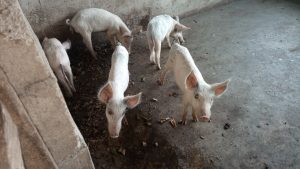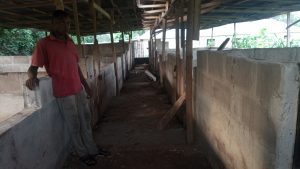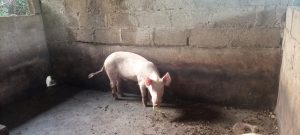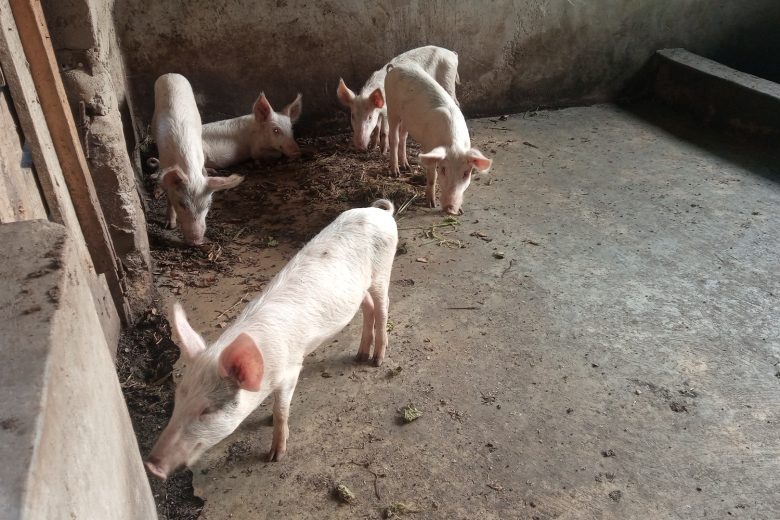Starting a pig farming business in Uganda is a lucrative business any wise farmer will look into.
To start a pig farming business in Uganda (piggery) you need start-up capital, you need a farmland location, erect ponds, buy good fingerlings, and formulate quality feeding plans for your fish.
Uganda is one of the nations whose national Gdp relies majorly on agriculture activities. The government also are embarking on strategic planning to boost the rate of agriculture practice in the nation.
Step By Step Guide To Start A Pig Farming Business In Uganda

Step 1: Get a start-up capital
The first thing before planning any business is to get funds to finance your intending business.
You will need capital to procure farmland, buy pig equipment, buy feed and also run the farm.
Read Also: How To Start Fish Farming Business In Uganda [Beginners Guide]
Step 2: Buy a farmland
As a newcomer to pig farming, a piece of land is a good place to begin. A huge field is necessary for large-scale pig farming since it will allow the pigs to graze in the open before returning to the pen, where they will continue grazing and playing.
The land is your most important investment when starting a pig farming business. You’re halfway to building a thriving commercial empire if you can get your hands on some pig farming.
Read Also: Udder Edema in Cow [Causes, Symptoms & Treatment]
Purchasing farmland in a rural region can save you a significant amount of money on your property taxes. 2.5m Uganda shillings is a reasonable price to pay for an acre of land in the countryside.
You should conduct extensive research before acquiring farmland for this business. ” You’ll be able to move your supplies to a nearby town as soon as the land is ready. To save on transportation costs, butchers may come to your farm to purchase their products directly.
Read Also: How To Start Goat Farm Business In Uganda [Beginners Guide]
Step 2: Construct your pig pen

A large pen is required if you don’t want the pigs to get hurt. Your money can be saved if you have a well-equipped and well-ventilated kennel. To keep disease vectors out of the pen, a well-designed drainage system is a necessity.
You’ll need to build a water pool where your pigs may play, swim, and cool down in order to keep them clean. Their well-being depends on this idea.
Read Also: Congested Udder in Cow [Causes, Symptoms & Treatment]
Step 3: Fumigate your farm against pig diseases
There are diseases and common infections that may besiege your farm which you need to guide against.
Fumigating your farm against diseases and infection is necessary.
Ensure you do not take this step lightly.
Read Also: Udder Edema in Sheep [Causes, Symptoms & Treatment]
Step 4: Procure a Healthy pig breed

Additionally, a thorough investigation of pigs can save you money.
You’ll lose a lot of money if you buy piglets that have no known history. Piglets having a history of vaccination should be considered for purchase.
Read Also: Congested Udder in Sheep [Mastitis Causes, Symptoms & Treatment]
It’s best to start with a modest number of piglets and then gradually increase the number.
Eventually, you’ll know everything there is to know about pig farming, and your risk will be negligible.
Read Also: How To Start Bee Farming [Step By Step Guide]
Step 5: Hire Farmworkers
In order to start your own small-scale pig farming business, you will need at least 4-5 people to help you clean and feed the pigs.
It is recommended to hire people who have prior experience with pig farms or better still have a passion for animal Farming.
Step 6: Formulate a quality feeding plan for your pigs
Pigs can’t grow and develop properly unless they’re fed properly.
Healthful eating means a healthy business. Unless you feed your pigs properly, your pig farming business will fail.
Read Also: Coccidiosis in Goats [Causes, Symptoms, and Treatment]
Pigs must be fed high-fiber, high-carbohydrate, high-vitamin, high-protein, and high-mineral meals in order to thrive.
Feeding pigs is solely for the purpose of getting them ready for market, thus it must be done correctly.
Step 7: Provide quality water supply to your farm
As with any farm animal, pigs need access to fresh water at all times. To keep pigs happy, their water must be replaced on a regular basis.
It’s important to include galvanized troughs in your pig farming budget. In order to ensure that your pigs are living in a clean and healthy environment, you must follow all required procedures.
Read Also: Albon for Goats [All You Should Know]
Step 8: Register with A vet
You’ll also need to hire a veterinarian for monthly checkups, vaccinations, and proper feeding and nutrition.
Pig Farming For Beginners In Uganda Pdf:
Common Pig Diseases
- African Swine Fever (ASF): ASF is a highly contagious viral disease that affects domestic pigs and wild boars. It can cause high fever, loss of appetite, internal bleeding, and high mortality rates. Strict biosecurity measures, proper quarantine procedures, and control of pig movement are critical for preventing the introduction and spread of ASF.
- Porcine Reproductive and Respiratory Syndrome (PRRS): PRRS is a viral disease that primarily affects the respiratory and reproductive systems of pigs. It can cause reproductive failures, respiratory issues, and decreased growth rates. Vaccination, biosecurity protocols, and herd management practices are essential for preventing and controlling PRRS.
- Swine Dysentery: Swine dysentery is a bacterial disease that affects the large intestine of pigs. It leads to bloody diarrhea, weight loss, and reduced productivity. Strict hygiene practices, proper sanitation, and antibiotic treatment are necessary to control and prevent swine dysentery.
Read Also: Miscarriage in Cows [Signs, Causes, and How to Prevent]
Common Pig Pests
- External Parasites (Mites, Lice, Fleas): External parasites can infest pigs, causing skin irritation, itching, hair loss, and anemia. Regular inspection, proper housing, and use of appropriate acaricides or insecticides can help control external parasites.
- Internal Parasites (Roundworms, Whipworms): Internal parasites can affect pig health and productivity, causing digestive issues, poor weight gain, and anemia. Regular deworming, proper hygiene, and pasture management are crucial for controlling internal parasites.
- Flies and Maggots: Flies and maggots are common pests in pig farms and can cause annoyance, stress, and potential disease transmission. Good sanitation practices, waste management, and fly control methods such as traps and insecticides can help manage fly populations.
Read Also: Miscarriage in Cows [Signs, Causes, and How to Prevent]
Prevention and Management Strategies
To effectively prevent and manage diseases and pests in pig farming in Uganda, consider the following strategies:
- Biosecurity Measures: Implement strict biosecurity protocols to prevent the entry and spread of diseases on the farm. This includes controlling farm access, proper disinfection procedures, and avoiding contact with potentially infected pigs.
- Vaccination and Testing: Follow recommended vaccination schedules for common pig diseases and regularly test for specific diseases to detect any potential outbreaks early and take appropriate actions.
- Proper Hygiene and Sanitation: Maintain clean and hygienic pig housing, feeding areas, and water sources. Dispose of manure properly and ensure proper waste management to minimize disease transmission.
- Quarantine and Isolation: Quarantine new animals before introducing them to the main herd. Isolate sick pigs to prevent the spread of diseases and provide appropriate treatment or veterinary care.
- Regular Monitoring and Health Checks: Monitor pigs closely for any signs of illness or abnormal behavior. Conduct regular health checks and promptly address any health issues that arise.
Pig farming in Uganda presents significant opportunities for farmers, but it is essential to be aware of the common diseases and pests that can impact pig health and productivity.
Read Also: [Beginners Guide] How To Formulate Pig Feed In Uganda
By implementing preventive measures, such as strict biosecurity protocols, vaccination, proper hygiene practices, and regular monitoring, pig farmers can protect their herds and ensure a successful and profitable pig farming business.
How often should pigs be dewormed?
The deworming frequency depends on factors such as pig age, health status, and local parasite prevalence. Consult with a veterinarian to develop a deworming schedule tailored to your specific farm conditions.
Read Also: [Beginners Guide] How To Start Fish Farming Business In Uganda
Are there any natural remedies for managing pig pests?
While natural remedies like herbal preparations may offer some benefits, it’s important to consult with a veterinarian for appropriate and effective pest management strategies to ensure the well-being of your pigs.
What are the signs of a potential disease outbreak in pigs?
Signs of a potential disease outbreak in pigs include decreased appetite, lethargy, coughing, diarrhea, and abnormal behavior. Promptly isolate and seek veterinary advice if any such signs are observed.
Can pigs develop immunity to diseases over time?
Pigs can develop immunity to certain diseases through exposure or vaccination. However, maintaining proper biosecurity measures, vaccination protocols, and regular monitoring are essential to minimize disease risks and maintain a healthy pig herd.
Is Pig Farming Profitable In Uganda?
Pig farming is one of the most lucrative farming businesses to practice in Uganda. As a pig farmer, you can earn at least 50% to 60% ROI on your invested capital in the shortest time.
How Much Does A Pig Cost In Uganda?
A pig is sold for 60,000 Uganda shillings.
How Much Does It Cost To Raise A Pig In Uganda?
To raise a pig in Uganda, it cost between 25,000 to 50,000 Uganda shillings.
Is Pig Farming A Good Investment?
Yes, pig farming is a good investment. Pigs can give birth to more than 10 piglets at a time, consider having 3 sows giving birth to 10 children at a time, that is 30 piglets at a go. Calculate your profit with this little illustration and see how profitable pig farming it.
Best Pig Breed For Commercial Farming In Uganda
the large white is the best pig breed to raise in Uganda for commercial purposes.
Biggest Pig Farm In Uganda
In Uganda Charles Kawuma Pig farm is the biggest pig farm, having over 2,000 pigs in his farm and different workers working on the farm at a time.
Conclusion
To keep a pig is a business that is on the list of the top 5 most lucrative farming businesses in Uganda. We have provided you with a detailed guide on how to start one, if you need help citing a pig farm in Uganda, you can get across to us via the comment section below.





thanks update me always
Thank u so much but I would like to know where can I get a good piglet
You are welcome Dear. To get a closer recommendation, drop your location.
I what to start pig project soon so i need to know which type of piglets should i start with
The best piglet you can start a pig farm with is large white piglet.
Thanks for platform, I need 10 large white piglets for start.
My contact is 0771330765
I request for your guidance on how I can construct a medium sized piggery structure in terms of design
Here is how to can construct a medium-sized piggery structure in terms of design
1. Research: Research the ideal size and design for a medium-sized piggery structure. Consider factors such as the size of the area and the number of pigs you plan to keep.
2. Layout: Draw up a preliminary layout of the structure, taking into account factors such as the location of the pens, the size of the building, and the size of the pens.
3. Materials: Select the appropriate materials for the construction of the structure. Consider factors such as the weather conditions and the expected lifespan of the structure.
4. Foundation: Lay the foundation for the structure in accordance with the layout. Make sure the foundation is level and secure.
5. Walls: Construct the walls of the structure, taking care to ensure that they are strong and secure enough to contain the pigs.
6. Roof: Install the roof of the structure in accordance with the layout. Make sure it is waterproof and well insulated.
7. Fencing: Install the necessary fencing to contain the pigs. Make sure it is strong and secure enough to keep the animals in.
8. Ventilation: Install adequate ventilation to ensure that the pigs have enough air.
9. Insulation: Ensure that the structure is well insulated to keep the pigs comfortable in both hot and cold weather.
10. Feeders: Install the necessary feeders to provide the pigs with food and water. Make sure they are easy to access and maintain.
11. Finishing touches: Add any additional features such as gates or lighting to complete the structure.
Can i visit yr farm for lessons including book keping? If so, where are u located
I have appreciated your effort
It’s my pleasure
This is great.wish to learn further
You can learn More by looking for more information on this platform, search anything you wish to know, it will be given to you, thanks.
A very big fan of piggery.My only impediment is the fear of risk involved in this venture.If I have 2,000,000 shillings,Please is this enough to cater for pigs stock/ how many , construction of the pen and treatment.What is the viability of this investment??
This budget will only take care of 2-3 sows, it will not be enough to raise the pen and will not be enough to pay the treatment, you may start small, you may start with 2 sows in a small area, then you start gathering resources to expand as you continue.
Thanks for your expert opinion, it’s rewarding l appreciate it. However l want to know between these breeds of pigs which one is high yielding interms of production and how much are there piglets, and they available at your farm .
1- Large white
2- landrace
3- cumraff
Thanks
Both the Large White and Landrace breeds offer remarkable production qualities, with a comparable litter size of 10 to 14 piglets per litter. The choice between the two will likely depend on specific management strategies, environmental factors, and market preferences.
i do not have information about the said cumraff breed, however, i will make more research on that and possibly get back to you.
but here is quick overview of the two specie:
Large White Pig:
The Large White pig, also known as the Yorkshire pig, stands out for its exceptional production capabilities. Renowned for its efficient conversion of feed into lean meat, this breed is a favorite among commercial pig farmers. With a focus on high meat yield, Large Whites are exceptional for meat production. Additionally, their litter size is impressive, typically ranging from 10 to 14 piglets per litter. This combination of efficient meat conversion and a substantial number of piglets per litter makes the Large White a prime choice for farmers aiming for optimal meat output and economic viability.
Landrace Pig:
The Landrace pig, recognized for its superb maternal qualities and meat production, is another top contender in the realm of pig farming. Like the Large White, Landrace pigs excel in meat yield and are revered for their ability to raise large litters with skillful mothering. Their litter size typically falls within the range of 10 to 14 piglets per litter, showcasing a parallel productivity to the Large White. Landrace pigs’ unique attribute is their exceptional maternal instincts, which contribute to the survival and thriving of their offspring. Farmers seeking a breed that combines solid meat production with robust maternal care often opt for Landrace pigs to capitalize on these valuable traits.
Where can I get trained in pig keeping. I need more knowledge on how to run a pig farm.